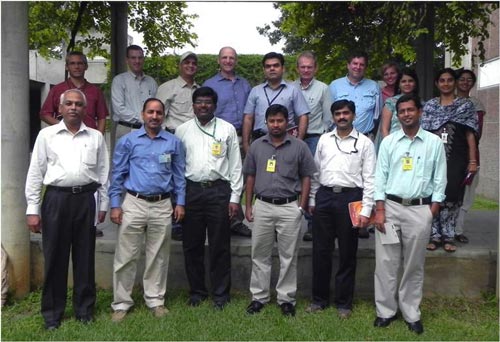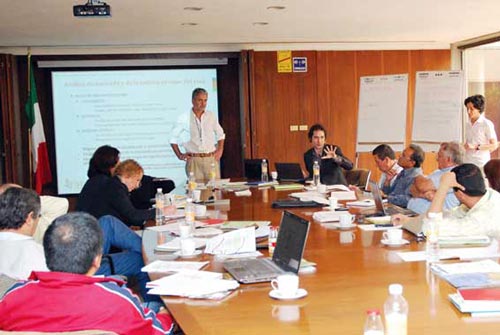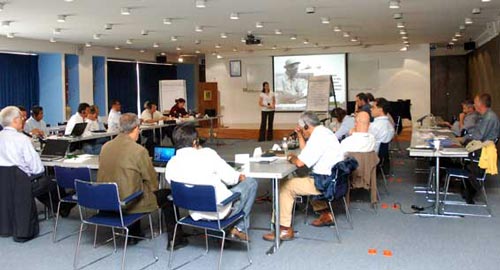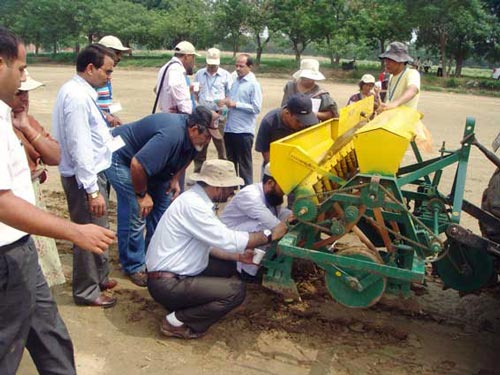A celebration was called for last Friday, 29 July 2011, when 24 technicians graduated from CIMMYT’s course in Conservation Agriculture (CA). Amidst the scenic setting of the Guest House Garden at El Batán, participants and their families gathered to hear speeches from CA stakeholders, and enjoyed a relaxing meal in the sunshine.
Bram Govaerts, Head of the Mexico Based Conservation Agriculture Program, opened the ceremony by thanking the distinguished guests and associates, particularly ASGROW and Fundación Produce Estado de México, who were especially supportive of CA when the program began several years ago, and the Mexican government and SAGARPA whose funding has enabled upscaling. “Mexico showed leadership,” he said. SAGARPA was represented at the event by Omar Musalem, Chief of Staff of the Minister, who highlighted the importance of the CA certification, especially in the broader context of trying to improve food security worldwide.
This sentiment was echoed by Scott Ferguson, CIMMYT Deputy Director General for Support Services, who also emphasized the need for graduates of the course to spread their knowledge to farmers, not only via mass communication technologies, but also through personal interactions. “Your personal qualities, particularly your ability to listen and communicate, are easily as important as the techniques you have learned,” he said. Ferguson proposed that whilst the number of current graduates is small, the skills they have learnt are vital in limiting damage to our environment, assisting farmers, stimulating the economy, and generating a multiplier effect by teaching others. These are the key objectives of MasAgro, and by passing these messages on to others, CA graduates can have a real impact on the future of agriculture in Mexico. Andrea Chocobar, CA team member, said that the certification received by the graduates “is not a gift or a prize, but rather a stimulus to continue in the difficult and occasionally unsung job we carry out.”
Before graduates received their certificates, goodie bags, and much-coveted CA T-shirts, testimonials were given by a graduate of last year, Jesus Cerecero, and current representative, Floricela Hernández. Reflecting on his year since graduation, Cerecero said that the course had made him aware of the important commitment to CA and to farmers, who are the ones that “sow, cultivate, and harvest the bread that feeds us.” Hernández agreed, saying “the success or failure of CA depends on us [technicians]. Farmers commit themselves when they see our commitment.”
The ceremony celebrated one year of hard work on behalf of both the participants and organizers, which culminated in a day-long exam with 11 practical and 6 theory stations. This practical element marks CIMMYT’s CA course apart from others; as participant Ricardo Canales said, “it’s different, because in a course you can learn theory and that’s all, then you forget things. Here however, you have to prove through a CA module [implemented with farmers] what you have learnt in theory.”
CA training has given the technicians the skills to conserve natural resources whilst increasing productivity; “working smarter not harder,” according to Ferguson. With six times more graduates this year than the previous one, and already over 120 applications received for the next courses, in alignment with government efforts in the frame of MasAgro, it is hoped that the number of CA-certified technicians will grow to meet agricultural challenges in the future.




 Training was mostly field-oriented, with participants practicing key CA principles in the field. The diverse makeup of the group also meant that some participants were less experienced in CA, therefore encouraging regional cross-learning, increasing capacity and helping to promote CA.
Training was mostly field-oriented, with participants practicing key CA principles in the field. The diverse makeup of the group also meant that some participants were less experienced in CA, therefore encouraging regional cross-learning, increasing capacity and helping to promote CA.